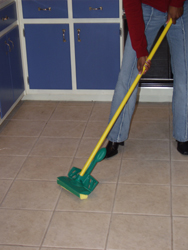
Back مطهر Arabic Дезинфекция Bulgarian সংক্রমণ নিবারক Bengali/Bangla Desinfectant Catalan Desinfektionsmittel German Απολυμαντικό Greek Seninfektigo Esperanto Desinfektatzaile Basque گندزدا Persian Desinfiointi Finnish


A disinfectant is a chemical substance or compound used to inactivate or destroy microorganisms on inert surfaces.[1] Disinfection does not necessarily kill all microorganisms, especially resistant bacterial spores; it is less effective than sterilization, which is an extreme physical or chemical process that kills all types of life.[1] Disinfectants are generally distinguished from other antimicrobial agents such as antibiotics, which destroy microorganisms within the body, and antiseptics, which destroy microorganisms on living tissue. Disinfectants are also different from biocides—the latter are intended to destroy all forms of life, not just microorganisms. Disinfectants work by destroying the cell wall of microbes or interfering with their metabolism. It is also a form of decontamination, and can be defined as the process whereby physical or chemical methods are used to reduce the amount of pathogenic microorganisms on a surface.[2][3]
Disinfectants can also be used to destroy microorganisms on the skin and mucous membrane, as in the medical dictionary historically the word simply meant that it destroys microbes.[4][5][6]
Sanitizers are substances that simultaneously clean and disinfect.[7] Disinfectants kill more germs than sanitizers.[8] Disinfectants are frequently used in hospitals, dental surgeries, kitchens, and bathrooms to kill infectious organisms. Sanitizers are mild compared to disinfectants and are used majorly to clean things that are in human contact whereas disinfectants are concentrated and are used to clean surfaces like floors and building premises.[citation needed][9]
Bacterial endospores are most resistant to disinfectants, but some fungi, viruses and bacteria also possess some resistance.[10]

In wastewater treatment, a disinfection step with chlorine, ultra-violet (UV) radiation or ozonation can be included as tertiary treatment to remove pathogens from wastewater, for example if it is to be discharged to a river or the sea where there body contact immersion recreations is practiced (Europe) or reused to irrigate golf courses (US). An alternative term used in the sanitation sector for disinfection of waste streams, sewage sludge or fecal sludge is sanitisation or sanitization.[citation needed]
- ^ a b "Division of Oral Health - Infection Control Glossary". U.S. Centers for Disease Control and Prevention. Archived from the original on 13 April 2016. Retrieved 19 April 2016.
- ^ Loveday HP, Wilson JA, Pratt RJ, Golsorkhi M, Tingle A, Bak A, et al. (January 2014). "epic3: national evidence-based guidelines for preventing healthcare-associated infections in NHS hospitals in England". The Journal of Hospital Infection. 86 (Suppl 1): S1-70. doi:10.1016/S0195-6701(13)60012-2. PMC 7114876. PMID 24330862.
- ^ Slater K, Cooke M, Fullerton F, Whitby M, Hay J, Lingard S, et al. (September 2020). "Peripheral intravenous catheter needleless connector decontamination study-Randomized controlled trial". American Journal of Infection Control. 48 (9): 1013–1018. doi:10.1016/j.ajic.2019.11.030. PMID 31928890. S2CID 210193248.
- ^ Rabenau HF, Kampf G, Cinatl J, Doerr HW (October 2005). "Efficacy of various disinfectants against SARS coronavirus". The Journal of Hospital Infection. 61 (2): 107–111. doi:10.1016/j.jhin.2004.12.023. PMC 7132504. PMID 15923059.
- ^ Story P (November 1952). "Testing of skin disinfectants". British Medical Journal. 2 (4794): 1128–1130. doi:10.1136/bmj.2.4794.1128. PMC 2021886. PMID 12987777.
- ^ Society for Applied Bacteriology (1981). Disinfectants: Their Use and Evaluation of Effectiveness. Academic Press. ISBN 978-0-12-181380-2.[page needed]
- ^ "Cleaning". Fodd Standards Agency. Retrieved 12 December 2019., (2009), Mid Sussex District Council, UK.
- ^ "Green Cleaning, Sanitizing, and Disinfecting: A Curriculum for Early Care and Education" (PDF). Retrieved 8 April 2019.
- ^ Roberts H (April 2020). "The difference between sanitizing and disinfecting. One kills more germs than the other". Insider.
- ^ Yeung YW, Ma Y, Liu SY, Pun WH, Chua SL (September 2022). "Prevalence of alcohol-tolerant and antibiotic-resistant bacterial pathogens on public hand sanitizer dispensers". The Journal of Hospital Infection. 127: 26–33. doi:10.1016/j.jhin.2022.05.017. PMC 9176178. PMID 35690267.